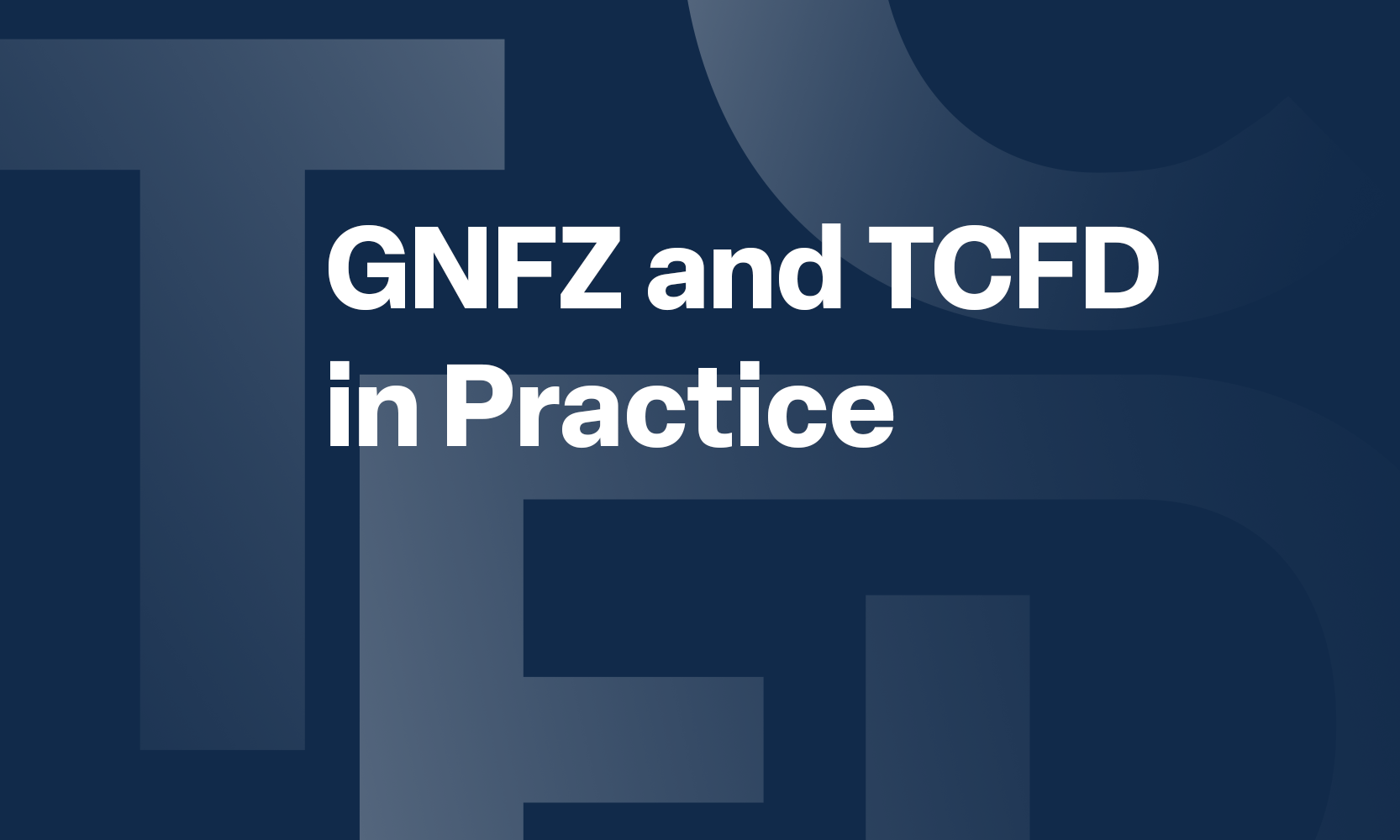How GNFZ verification strengthens TCFD credibility
GNFZ’s net zero certifications align with TCFD (Task Force on Climate-related Financial Disclosures). While GNFZ focuses more on verifying that an organization is on (or committed to) a credible net zero path and is action-oriented (certifying plans, emissions and progress), TCFD is focused on being transparent about climate risks and strategy to stakeholders, especially in financial terms, helping them understand how the organization is preparing, planning and managing climate-risks, opportunities and setting targets. Using both can be quite synergistic.
What is GNFZ net zero certification?
GNFZ’s net zero certifications recognize an organization’s GHG accounting, net zero commitments and transition plans. As a performance-based certification, it ensures companies and buildings can credibly claim net zero with independent third-party verification.
GNFZ certification is based on the GHG Protocol, a global framework for measuring, managing and reducing emissions from private and public sector operations, value chains, products, cities and policies. GNFZ certification is rating system agnostic; aligns with the Paris Agreement and provides a path to calculate and eliminate Scope 1, 2 and 3 emissions. Built with total flexibility in mind, you can leverage the standard or framework of your choice to decarbonize and achieve certification for your building, portfolio or business.
Achieving GNFZ certification supports and aligns with most of the current ESG centric standards and frameworks for various countries and regions, focused on the “environmental” pillar of ESG. This has been discussed in our previous crosswalk comparing and showing alignments between GRI and GNFZ.
What is TCFD?
TCFD was created by the Financial Sustainability Board (FSB) to provide a framework and set of recommendations for organizations to disclose climate-related financial risks and opportunities in a consistent, decision-useful way, especially for investors and other financial stakeholders. It has four core thematic pillars:
Governance
Strategy
Risk Management
Metrics and Targets
TCFD recommends that the disclosures should include factors like scenario analysis (how the strategy holds up under climate change trajectories), material risks and opportunities, and financial impacts. TCFD uses quantitative metrics like GHG emissions (Scope 1 and 2, and Scope 3 if material), targets, performance and more, and the disclosures must be published in mainstream reports, financial filings, etc. It is not a certification — rather, its focus on transparency enables financial markets and stakeholders to assess risk and strategy.
How does GNFZ certification support TCFD?
There are multiple areas of overlap where GNFZ certification provides a strong data foundation for supporting the TCFD disclosures.
Governance and Accountability
TCFD requires business entities to disclose governance around climate risks and opportunities, and describe board oversight and management’s role in assessing and managing risks.
Though GNFZ doesn’t directly require documentation of governance structure, the process followed during certification requires a governance and oversight of internal organizational processes, quality control and more related to certification. An internal lead is assigned for net zero planning and data collection, and policies must be established for emissions monitoring and verification — which overlaps with TCFD disclosures for facilitation and enablement.
Strategy
TCFD requires disclosure of climate-related risks and opportunities and their impact on the organization’s business model, strategy and financial planning, as well as use scenario analysis to assess resilience.
GNFZ certification also requires organizations to strategize around climate-related risks and opportunities and develop a net zero plan including baseline, targets, emissions reduction pathways and elimination strategy. GNFZ net zero certification includes milestones for assessment, plan development and certification. The GNFZ net zero plan can be combined with TCFD scenario analysis (e.g., 1.5°C and 2°C pathways). Organizations can also integrate emissions and financial implications into annual strategy reviews. So, GNFZ certification provides actionable data that supports TCFD narrative and offers an incremental approach that aligns with the strategic imperative of TCFD.
Risk Management
TCFD disclosures require organizations to describe processes for identifying, assessing and managing climate risks as well as explain how these are integrated into Enterprise Risk Management (ERM).
The GNFZ certification process covers the “environmental” aspect of ESG by way of establishing an emissions baseline assessment (Scope 1, 2 and 3). It encourages identification of transition risks (carbon pricing, regulation) as well as physical risks relevant to operations that will be alleviated in due time by achieving the net zero certification. Such risk mitigation strategies can be disclosed for TCFD compliance.
Metrics and Targets
GNFZ metrics feed TCFD metrics, and the net zero achievement plan and milestone tracking feeds the disclosures on targets.
GNFZ certification quantifies Scope 1, 2 and 3 emissions using the GHG Protocol, requires the entity to define interim and long-term targets toward net zero and tracks annual emissions reductions. All these verified emissions data can be used for the TCFD metrics section.
Verification and Validation
TCFD disclosure requirement states that external assurance is optional but increasingly expected for credibility. GNFZ provides third-party verification of emissions, plans and performance (required for certification). This is complementary — GNFZ verification strengthens TCFD credibility. Entities can include GNFZ certificates as assurance evidence in TCFD disclosures.
Transition Plan and Implementation
Entities are expected to explain transition strategy under TCFD’s “strategy” pillar. The GNFZ net zero plan and milestones tracking provides concrete content for TCFD. Entities can reuse GNFZ’s transition plan sections in TCFD reporting and quantify capital allocation to decarbonization.
Financial Impact Analysis
TCFD requires entities to disclose the financial impact of climate risks and opportunities, where material. Entities can integrate the cost of GNFZ measures into TCFD financial impact disclosures as well as link carbon pricing assumptions, ROI and resilience outcomes to the financial impact analysis for TCFD.
Scenario Analysis
TCFD has a mandatory disclosure requirement to analyze resilience under different climate scenarios. As part of the net zero assessment and planning stages under GNFZ certification, entities can use the GNFZ emissions baseline and reduction pathway as input for TCFD scenario models and test 1.5°C vs 2°C trajectories for financial impact.
Communication and Transparency
TCFD requires public disclosure through annual report or sustainability statement. GNFZ provides certification marks and reports for stakeholders, as well as supports organizations’ voluntary disclosure of progress on their website or sustainability report. Both GNFZ and TCFD aim to increase transparency.
Continuous Improvement
Annual review and update of TCFD disclosures is required to reflect evolving risks and strategy. GNFZ supports annual recertification and milestone review, and updates to plans based on performance. GNFZ updates can be used to refresh TCFD reporting and organizations can synchronize both reviews in the same annual ESG or sustainability cycle.
GNFZ and TCFD in Practice
GNFZ and TCFD can complement each other quite well. For example, an organization could achieve GNFZ certification to demonstrate credible net zero planning and implementation while also using TCFD-aligned disclosures to provide transparency to investors about risks, scenario resilience, targets and performance. The metrics and emissions data collected for GNFZ (to measure and verify progress) can feed into what is disclosed under TCFD: emissions, targets, strategies and performance. The certification gives external verification, which strengthens the credibility of disclosures under TCFD. TCFD’s framework ensures that climate risks (physical and transition) are considered more broadly, such as how climate change affects business models, strategies and financial resilience.

